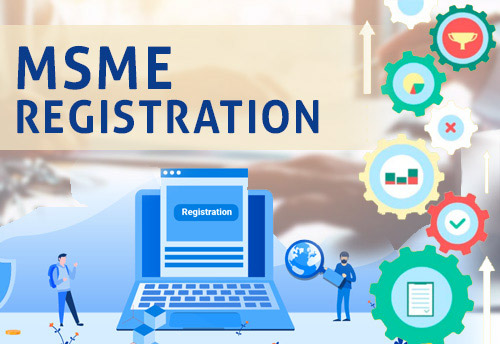All You Must Know About MSME Registration in 2022:

What is MSME?
MSMEs produce a little over 8% of the nation’s GDP, about 45% of the nation’s manufacturing output, and about 40% of the nation’s exports. They serve as the foundation of the nation’s economy.
The Government of India has established the MSME, or Micro, Small, and also the Medium Enterprises, following the Micro, Small, and the Medium Enterprises Development (MSMED) Act of 2006. Production, manufacture, processing, or preservation of goods and commodities is the main activity of these businesses.
MSMEs are a significant segment of the Indian economy and have significantly contributed to India’s socioeconomic development. They also aid in advancing the nation’s rural and underdeveloped regions. According to the government’s annual report, there are around 6,08,41,245 MSMEs in India (2018-19).
Features of MSMEs:
MSMEs need the following components:
- Make an effort to improve a lot of workers and craftsmen
- Make available funds or credit limitations via banks
- Establish specialized training facilities to encourage entrepreneurship and skill development
- Encourage technological, infrastructure, and modernization development
- Help people have better access to both home and foreign markets
- Offer cutting-edge testing facilities and quality control
- Help with product development, packaging, and design intervention
MSMEs’ contribution to India’s economy:
The MSME segment has established itself as a dynamic sector of the Indian economy since its beginnings. Products are created and manufactured by small and medium-sized businesses (SMEs) for both domestic and international markets. They have aided the expansion and development of the coir, khadi, and village industries. They have cooperated and worked with the relevant ministries, state governments, and stakeholders to ensure the development of rural areas.
The MSME sector has significantly aided the country’s socioeconomic growth as a unit that complements large enterprises. MSMEs have created crucial job prospects in rural areas. They have helped these places become more industrialized at a cheaper cost than significant industries.
MSMEs provide essential services in various areas, including low investment and operational flexibility, mobility between sites, cheap imports, and high local production, in addition to helping the nation develop.
It has the potential to create appropriate local technology, tough domestic and international competition, assist tech-savvy companies, aid in the production of defense materials, and foster the growth of new entrepreneurs by offering education, training, and skill improvement.
How significant are MSMEs to India’s economy?
It is generally acknowledged that MSMEs contribute to global economic growth and equitable development. They produce the fastest rate of change in the economy. MSMEs have helped India reach new heights because of their minimum capital requirements, operational flexibility, and capacity to create indigenous innovations.
MSMEs are the second largest employer after agriculture, employing about 120 million people. This sector provides around 6.11% of the GDP in the entire nation from manufacturing and 24.63% from services. India’s MSME ministry wants to see a 50% GDP contribution by 2025 as the country moves toward a $5 trillion economy.
This country is where almost 45% of Indian exports go.
Small and medium-sized businesses support growth that is inclusive of all people by producing jobs, especially for those from rural areas who belong to the weakest portions of society.
MSMEs encourage innovation by allowing business owners to develop innovative products, increasing business growth and competition.
The MSME sector offers covert assistance to the national economy as a buffer against shocks and adversities in the global economy. India is set to develop into a robust global economy through a quiet revolution driven by MSMEs.
MSME: Registration paperwork is necessary:
The Aadhaar Card and the PAN Card are the sole documents needed for MSME registration. There is no need for any additional documentation for the MSME registration process, which is entirely online. The PAN and GST-related data on investments and revenue of businesses would be automatically gathered through the Udyam Registration Portal from government databases. The Udyam Registration Portal has been fully connected with GSTIN and Income Tax.
MSME: Procedure for registering:
To register your business online, take the following actions:
- Visit the company’s website.
- Select the choice that most accurately reflects where your registration is at. The “For the New Entrepreneurs who are not Registered as MSME or those with EM-II” button can be selected by new business owners. But if you want to switch to Udyam or re-register, choose one of the following:
- For those who are already registered as UAM
- For people who have already registered as UAMs through assisted filling
- If you select the button for new business owners, the registration page will open. The entrepreneur must now input their name and Aadhaar number (as displayed on Aadhaar). Check the box next to “Validate & Generate OTP” to activate it.
- After entering your PAN information on the following page and verifying your Udyam registration information, the registration procedure will be finished. Without a PAN card, an entrepreneur can skip this step and fill out the registration information to complete the registration procedure.
- Select whether you want to migrate or re-register. This will direct you to a different page.
- Input your Udyog Aadhaar number here.
- Choose your OTP generation choice from the following:
- OTP on Mobile with UAM Information
- Fill out the UAM OTP in the email.
- Click Validate & Generate OTP.
Your Udyam migration or re-registration will be finished once you enter your OTP and complete the registration information.
MSME: Enrollment fees:
MSMEs can register without cost on the government portal. Enterprises holding UAM registration must switch to Udyam Registration as of June 30, 2022. Entrepreneurs’ UAM registrations will expire on June 30, 2022, and they won’t be eligible for any MSMEs-specific incentives because they still need to upgrade to Udyam Registration. They must re-register with Udyam to receive MSME benefits.
MSME: Certificate of Registration:
After completing the online MSME registration form, you will get a reference number in an email. After confirming the data on the registration form, the Ministry of MSME will deliver the Udyam Registration certificate or MSME certificate to the email address supplied by the entrepreneur.
A few days after the registration is finished, the Ministry will issue MSME certificates. They are eternally compelling. It’s not necessary to renew.
MSME: How to obtain an online MSME certificate:
An entrepreneur must go to the Udyam Registration portal and download the MSME certificate to obtain an MSME certificate online. Follow these steps to receive the MSME registration certificate:
- On the portal’s home page, entrepreneurs, must click the ‘Print/Verify’ button, and then they must click the ‘Print Udyam Certificate’ link.
- Entrepreneurs must enter their Udyam Registration Number and mobile number and choose the OTP option on the following screen before clicking the “Validate and Generate OTP” button.
- Enter the OTP and click the “Validate OTP and Print” button.
- The page displays the MSME registration certificate, which is printable. After submitting the MSME registration form, entrepreneurs can use the reference number given to check their registration number.
A business owner can obtain the MSME registration number by selecting the “Verify Udyam Registration Number” option under the “Print/Verify” button on the homepage. The MSME information and registration number will be displayed on a screen. The entrepreneurs must enter the reference number and captcha code on the new page before clicking “Verify.”



